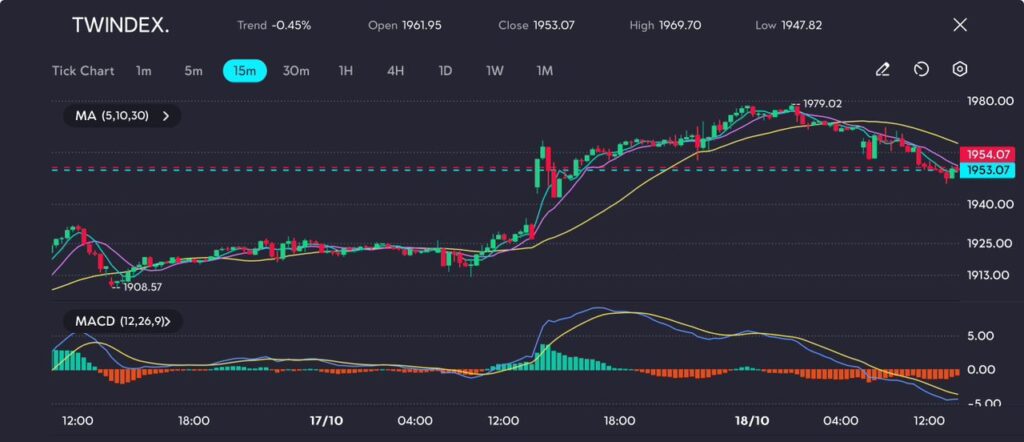Key points:
- TWINDEX rises as China’s stimulus sparks optimism, with Taiwan’s tech sector benefiting from improved regional sentiment.
- U.S. retail sales data strengthens the dollar, influencing demand for Taiwan’s key exports and shaping future tech sector growth.
China’s recent stimulus efforts have had a noticeable effect on Asian markets, with Taiwan’s TWINDEX benefiting from the broader regional impact of China’s policies.
While China’s economy continues to struggle, the People’s Bank of China’s (PBOC) launch of the Securities, Fund, and Insurance Swap Facility has provided a much-needed boost to the equity market.
China’s Stimulus Boosts Regional Sentiment
Mainland Chinese blue chips rose by 0.78%, and this optimism extended to Taiwan’s tech-driven economy, where the TWINDEX climbed in response to renewed hope for economic support across the region.
China’s third-quarter economic data confirmed that its economy grew at the slowest pace since early 2023, amplifying expectations for additional monetary easing measures.
This expectation is critical for Taiwan’s market, particularly given its heavy reliance on exports to China.
A resurgence in Chinese demand could provide support to Taiwan’s tech sector, which is a major driver of the TWINDEX.
Picture: TWINDEX falls to 1953.07, with bearish momentum building, as seen on the VT Markets app.
The TWINDEX chart shows a close at 1953.07, after reaching a session high of 1969.70 and a low of 1947.82.
The trend for the day reflects a modest decline of 0.45%. Moving averages (5, 10, 30-period) suggest a short-term downtrend, with the price moving below the moving averages.
The MACD (12, 26, 9) line has crossed below the signal line, with increasing negative histogram bars, indicating growing bearish momentum.
The global market environment has been shaped by the strength of the U.S. dollar, which has hovered close to an 11-week high.
Despite the dollar’s strength, U.S. retail sales data showed a stronger-than-expected 0.4% increase last month, giving the Federal Reserve greater flexibility in its rate-cut path.
This could indirectly impact Taiwan’s economy, as a more patient U.S. rate path could help stabilise global demand, especially for technology exports.
Taiwan’s TWINDEX, which tracks many semiconductor companies, will likely react to any shifts in U.S. monetary policy that influence tech demand.
U.S. Elections Push Tech Demands
Key to the TWINDEX’s future performance will be the evolving geopolitical landscape.
As Donald Trump gains traction in the U.S. presidential election, his potential tariffs and policies could fuel inflationary pressures, pushing gold to a new record high of $2,711.90.
These inflationary trends could have both positive and negative implications for Taiwanese exporters, depending on how global trade flows are impacted by U.S. trade policies.
Crude Oil on the Rise
In the broader commodities space, crude oil prices saw a slight increase, with Brent rising by 0.31% to $74.68 a barrel, supported by a surprise drop in U.S. inventories.
See also: Oil Prices Rise as Traders Eye China Stimulus
However, the looming concern over global demand kept prices from rising significantly, a factor that could indirectly affect Taiwan’s trade-dependent economy.
Traders on VT Markets who focus on the TWINDEX should monitor China’s fiscal and monetary policies closely, as further stimulus could lead to increased demand for Taiwanese tech products.
Additionally, movements in the U.S. dollar and shifts in U.S. monetary policy will play a critical role in shaping global market dynamics and their potential impact on Taiwan’s tech-heavy economy.
Start trading now — click here to create your live VT Markets account.








